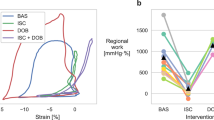Abstract
A miniaturized accelerometer fixed to the heart can be used for monitoring of cardiac function. However, an accelerometer cannot differentiate between acceleration caused by motion and acceleration due to gravity. The accuracy of motion measurements is therefore dependent on how well the gravity component can be estimated and filtered from the measured signal. In this study we propose a new method for estimating the gravity, based on strapdown inertial navigation, using a combined accelerometer and gyro. The gyro was used to estimate the orientation of the gravity field and thereby remove it. We compared this method with two previously proposed gravity filtering methods in three experimental models using: (1) in silico computer simulated heart motion; (2) robot mimicked heart motion; and (3) in vivo measured motion on the heart in an animal model. The new method correlated excellently with the reference (r 2 > 0.93) and had a deviation from reference peak systolic displacement (6.3 ± 3.9 mm) below 0.2 ± 0.5 mm for the robot experiment model. The new method performed significantly better than the two previously proposed methods (p < 0.001). The results show that the proposed method using gyro can measure cardiac motion with high accuracy and performs better than existing methods for filtering the gravity component from the accelerometer signal.








Similar content being viewed by others
Abbreviations
- GYRc:
-
Gravity compensation method using gyro
- CIRc:
-
Gravity compensation method using circle estimation
- STAc:
-
Gravity compensation method using static gravity estimation
References
Bland, J. M., and D. G. Altman. Statistical methods for assessing agreement between two methods of clinical measurement. The Lancet 327:307–310, 1986.
Comunale, M. E., S. C. Body, C. Ley, C. Koch, G. Roach, J. P. Mathew, A. Herskowitz, and D. T. Mangano. The concordance of intraoperative left ventricular wall-motion abnormalities and electrocardiographic S-T segment changes. Anesthesiology 88:945–954, 1998.
Elle, O. J., S. Halvorsen, M. G. Gulbrandsen, L. Aurdal, A. Bakken, E. Samset, H. Dugstad, and E. Fosse. Early recognition of regional cardiac ischemia using a 3-axis accelerometer sensor. Physiological Measurement 26:429–440, 2005.
Halvorsen, P. S., A. Espinoza, L. A. Fleischer, O. J. Elle, L. Hoff, R. Lundblad, H. Skulstad, T. Edvardsen, H. Ihlen, and E. Fosse. Feasibility of a three-axis epicardial accelerometer in detecting myocardial ischemia in cardiac surgical patients. The Journal of Thoracic and Cardiovascular Surgery 136:1496–1502, 2008.
Halvorsen, P. S., L. A. Fleischer, A. Espinoza, O. J. Elle, L. Hoff, H. Skulstad, T. Edvardsen, and E. Fosse. Detection of myocardial ischaemia by epicardial accelerometers in the pig. British Journal of Anaesthesia 102:29–37, 2009.
Halvorsen, P. S., E. W. Remme, A. Espinoza, H. Skulstad, R. Lundblad, J. Bergsland, L. Hoff, K. Imenes, T. Edvardsen, O. J. Elle, and E. Fosse. Automatic real-time detection of myocardial ischemia by epicardial accelerometer. The Journal of Thoracic and Cardiovascular Surgery 139:1026–1032, 2010.
Hanson, J. A. Visualizing Quaternions. San Francisco: Morgan Kaufmann Publishers, pp. a: 36, b: 335–337, 2006.
Helle-Valle, T., J. Crosby, T. Edvardsen, E. Lyseggen, B. H. Amundsen, H.-J. Smith, B. D. Rosen, J. A. C. Lima, H. Torp, H. Ihlen, and O. A. Smiseth. New noninvasive method for assessment of left ventricular rotation: speckle tracking echocardiography. Circulation 112:3149–3156, 2005.
Landesberg, G. Monitoring for myocardial ischemia. Best Practice & Research Clinical Anaesthesiology 19:77–95, 2005.
Nguyen, A.-T. T., F. Tjulkins, K. E. Aasmundtveit, N. Hoivik, L. Hoff, and K. Imenes. Miniaturization of package for an implantable heart monitoring device. Microsystem Technologies 21:1813–1826, 2015.
Remme, E. W., L. Hoff, P. S. Halvorsen, E. Naerum, H. Skulstad, L. A. Fleischer, O. J. Elle, and E. Fosse. Validation of cardiac accelerometer sensor measurements. Physiological Measurement 30:1429–1444, 2009.
Remme, E. W., L. Hoff, P. S. Halvorsen, A. Opdahl, E. Fosse, and O. J. Elle. Simulation model of cardiac three dimensional accelerometer measurements. Medical Engineering & Physics 34:990–998, 2012.
Slogoff, S., and A. S. Keats. Does chronic treatment with calcium entry blocking drugs reduce perioperative myocardial ischemia? Anesthesiology 68:676–680, 1988.
Tennant, R., and C. J. Wiggers. The effect of coronary occlusion on myocardial contraction. American Journal of Physiology: Heart and Circulatory Physiology 112:351–361, 1935.
Titterton, D. H., and J. L. Weston. Strapdown Inertial Navigation Technology. London: The Institution of Engineering and Technology, pp. 17–57, 2004.
Urheim, S., T. Edvardsen, H. Torp, B. Angelsen, and O. A. Smiseth. Myocardial strain by doppler echocardiography: validation of a new method to quantify regional myocardial function. Circulation 102:1158–1164, 2000.
Acknowledgment
The research leading to these results were funded by South-Eastern Norway Regional Health Authority [Project Number 2014076]. We thank the staff at the Intervention Center, Oslo University Hospital for support during the animal study.
Conflict of interest
Elle and Halvorsen are patent holders of the accelerometer technology for assessment of cardiac function and together with Krogh, Hoff and Remme share-holders in Cardiaccs A/S.
Author information
Authors and Affiliations
Corresponding author
Additional information
Associate Editor Zahra Moussavi oversaw the review of this article.
Rights and permissions
About this article
Cite this article
Krogh, M.R., Nghiem, G.M., Halvorsen, P.S. et al. Gravity Compensation Method for Combined Accelerometer and Gyro Sensors Used in Cardiac Motion Measurements. Ann Biomed Eng 45, 1292–1304 (2017). https://doi.org/10.1007/s10439-017-1798-4
Received:
Accepted:
Published:
Issue Date:
DOI: https://doi.org/10.1007/s10439-017-1798-4




